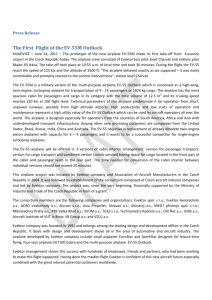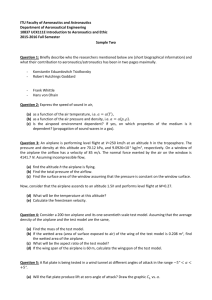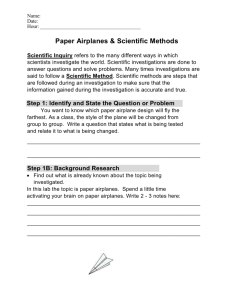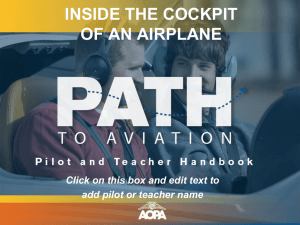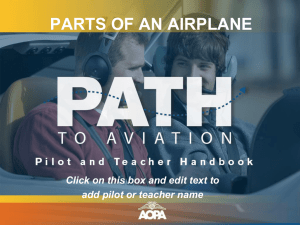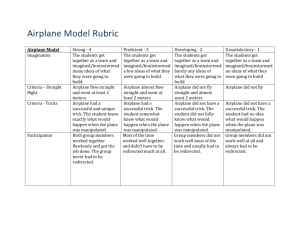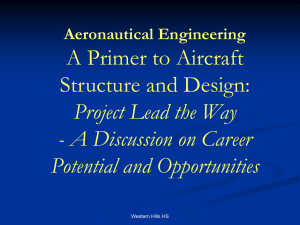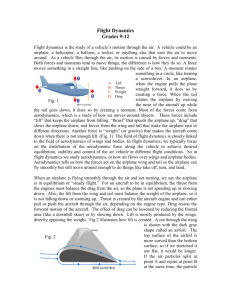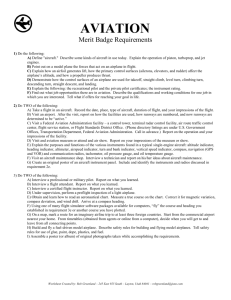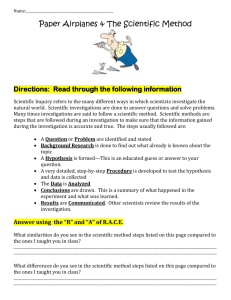Lindbergh Electric Airplane Flight (LEAF) Challenge
advertisement
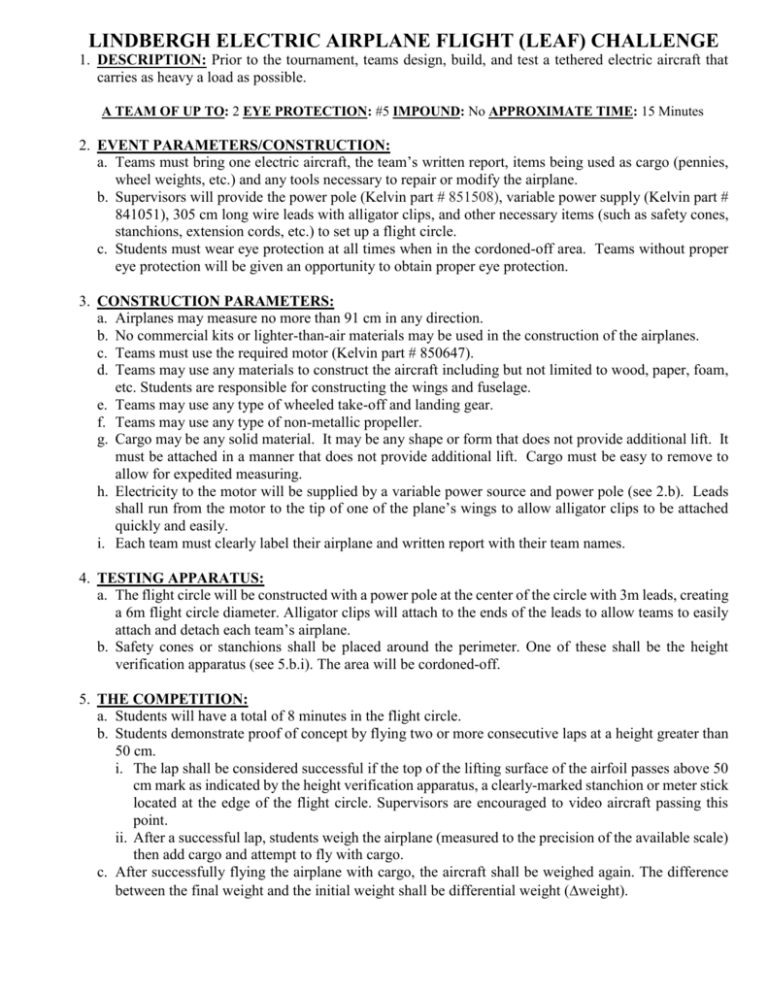
LINDBERGH ELECTRIC AIRPLANE FLIGHT (LEAF) CHALLENGE 1. DESCRIPTION: Prior to the tournament, teams design, build, and test a tethered electric aircraft that carries as heavy a load as possible. A TEAM OF UP TO: 2 EYE PROTECTION: #5 IMPOUND: No APPROXIMATE TIME: 15 Minutes 2. EVENT PARAMETERS/CONSTRUCTION: a. Teams must bring one electric aircraft, the team’s written report, items being used as cargo (pennies, wheel weights, etc.) and any tools necessary to repair or modify the airplane. b. Supervisors will provide the power pole (Kelvin part # 851508), variable power supply (Kelvin part # 841051), 305 cm long wire leads with alligator clips, and other necessary items (such as safety cones, stanchions, extension cords, etc.) to set up a flight circle. c. Students must wear eye protection at all times when in the cordoned-off area. Teams without proper eye protection will be given an opportunity to obtain proper eye protection. 3. CONSTRUCTION PARAMETERS: a. Airplanes may measure no more than 91 cm in any direction. b. No commercial kits or lighter-than-air materials may be used in the construction of the airplanes. c. Teams must use the required motor (Kelvin part # 850647). d. Teams may use any materials to construct the aircraft including but not limited to wood, paper, foam, etc. Students are responsible for constructing the wings and fuselage. e. Teams may use any type of wheeled take-off and landing gear. f. Teams may use any type of non-metallic propeller. g. Cargo may be any solid material. It may be any shape or form that does not provide additional lift. It must be attached in a manner that does not provide additional lift. Cargo must be easy to remove to allow for expedited measuring. h. Electricity to the motor will be supplied by a variable power source and power pole (see 2.b). Leads shall run from the motor to the tip of one of the plane’s wings to allow alligator clips to be attached quickly and easily. i. Each team must clearly label their airplane and written report with their team names. 4. TESTING APPARATUS: a. The flight circle will be constructed with a power pole at the center of the circle with 3m leads, creating a 6m flight circle diameter. Alligator clips will attach to the ends of the leads to allow teams to easily attach and detach each team’s airplane. b. Safety cones or stanchions shall be placed around the perimeter. One of these shall be the height verification apparatus (see 5.b.i). The area will be cordoned-off. 5. THE COMPETITION: a. Students will have a total of 8 minutes in the flight circle. b. Students demonstrate proof of concept by flying two or more consecutive laps at a height greater than 50 cm. i. The lap shall be considered successful if the top of the lifting surface of the airfoil passes above 50 cm mark as indicated by the height verification apparatus, a clearly-marked stanchion or meter stick located at the edge of the flight circle. Supervisors are encouraged to video aircraft passing this point. ii. After a successful lap, students weigh the airplane (measured to the precision of the available scale) then add cargo and attempt to fly with cargo. c. After successfully flying the airplane with cargo, the aircraft shall be weighed again. The difference between the final weight and the initial weight shall be differential weight (weight). d. Students may make as many attempts as time allows to increase the amount of cargo carried by the team’s plane. 6. SCORING: a. Scores will be comprised of three parts: i. Written Report Score (WR) (20 points) (1) Using the template provided by the Pacific Northwest American Institute of Aeronautics and Astronautics (AIAA), teams will submit their report electronically one or more weeks in advance of tournament to supervisor or designee. (2) The supervisor or designee will evaluate reports’ completeness and quality. (3) Reports submitted late may be evaluated at supervisor’s sole discretion and with a 5-point penalty. ii. Oral Defense Score (OD) (20 points) (1) Each team will answer questions from supervisor about their engineering process and aerodynamics principles that apply to the team’s plane. (a) Supervisors will ask the same 4 questions to each team. (b) Supervisors may ask up to 2 additional questions unique to particular teams’ designs or process. (2) Responses will be scored for alignment with engineering practices and the thoroughness of students’ understanding of principles of aerodynamics. iii. Design and Construction Score (DC) (30 points) (1) Each aircraft will be scored on the understanding of concepts, logical design, visual appeal, quality of construction and use of materials iv. Airplane Performance Score (AP) (30 points) 𝑚𝑎𝑥 ∆𝑤𝑒𝑖𝑔ℎ𝑡 − 𝑡𝑒𝑎𝑚′ 𝑠∆𝑤𝑒𝑖𝑔ℎ𝑡 𝑝𝑒𝑟𝑓𝑜𝑟𝑚𝑎𝑛𝑐𝑒 𝑠𝑐𝑜𝑟𝑒 = 60 − 𝑚𝑎𝑥 ∆𝑤𝑒𝑖𝑔ℎ𝑡 b. Overall score is calculated by adding written report score, oral defense score, and airplane performance score and design and construction score. 𝑂𝑣𝑒𝑟𝑎𝑙𝑙 𝑠𝑐𝑜𝑟𝑒 = 𝑊𝑅 + 𝑂𝐷 + 𝐷𝐶 + 𝐴𝑃 c. Airplanes will be scored in two tiers as follows: i. Tier 1: Airplanes that meet all construction parameters and have no competition violations. ii. Tier 2: Airplanes that have one or more construction violations. d. Ties between teams will be broken by the highest-scoring Airplane Performance followed (if necessary) by the highest-scoring Written Report. RECOMMENDED RESOURCES: Template and training resources are available on the project web site: http://www.leafchallenge.com THIS EVENT IS SPONSORED BY THE PACIFIC NORTHWEST SECTION OF THE AMERICAN INSTITUTE OF AERONAUTICS AND ASTRONAUTICS NATIONAL SCIENCE EDUCATION STANDARDS: Middle School- NGSS Forces and Interactions MS-PS2-2. Plan an investigation to provide evidence that the change in an object’s motion depends on the sum of the forces on the object and the mass of the object. Energy MS-PS3-1. Construct and interpret graphical displays of data to describe the relationships of kinetic energy to the mass of an object and to the speed of an object. Engineering Design MS-ETS1-1. Define the criteria and constraints of a design problem with sufficient precision to ensure a successful solution, taking into account relevant scientific principles and potential impacts on people and the natural environment that may limit possible solutions. MS-ETS1-2. Evaluate competing design solutions using a systematic process to determine how well they meet the criteria and constraints of the problem. MS-ETS1-3. Analyze data from tests to determine similarities and differences among several design solutions to identify the best characteristics of each that can be combined into a new solution to better meet the criteria for success. MS-ETS1-4. Develop a model to generate data for iterative testing and modification of a proposed object, tool, or process such that an optimal design can be achieved. High School- NGSS Forces and Interactions HS-PS2-1. Analyze data to support the claim that Newton’s second law of motion describes the mathematical relationship among the net force on a macroscopic object, its mass, and its acceleration. HS-PS2-2. Use mathematical representations to support the claim that the total momentum of a system of objects is conserved when there is no net force on the system. Energy HS-PS3-3. Design, build, and refine a device that works within given constraints to convert one form of energy into another form of energy. Engineering Design HS-ETS1-2. Design a solution to a complex real-world problem by breaking it down into smaller, more manageable problems that can be solved through engineering. HS-ETS1-3. Evaluate a solution to a complex real-world problem based on prioritized criteria and trade-offs that account for a range of constraints, including cost, safety, reliability, and aesthetics, as well as possible social, cultural, and environmental impacts

